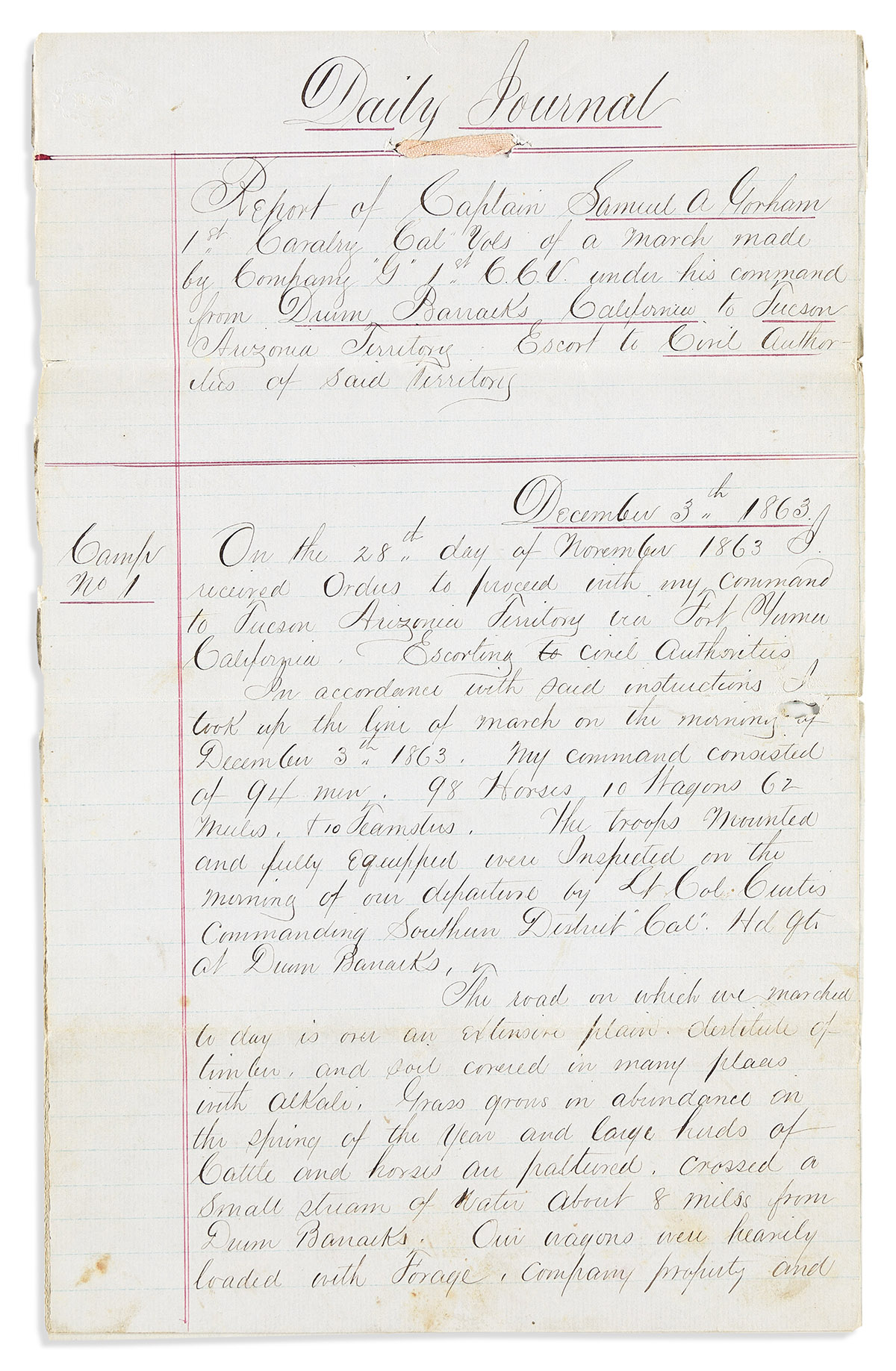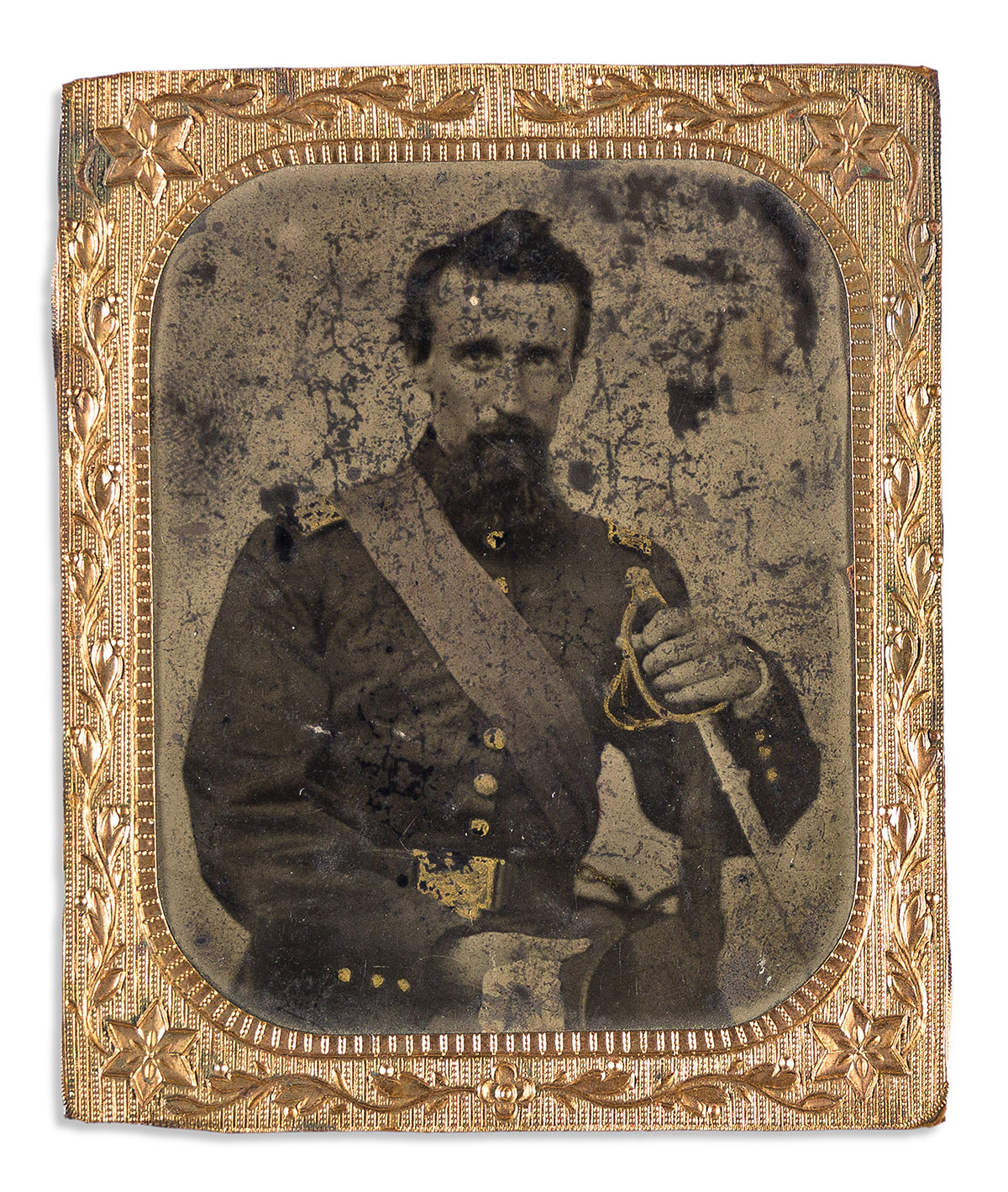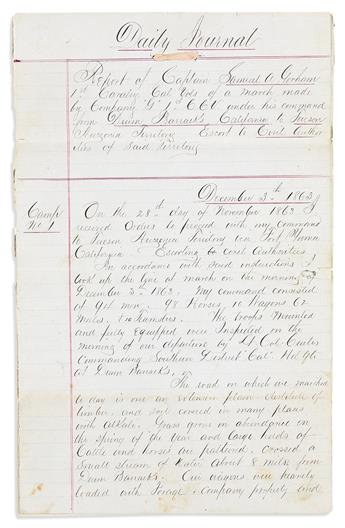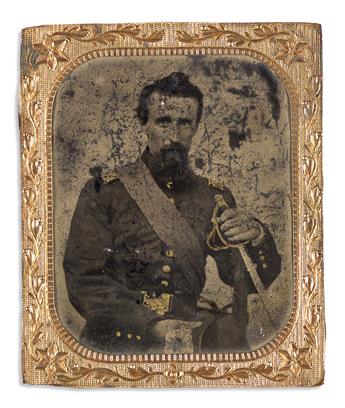Sale 2633 - Lot 41
Price Realized: $ 8,500
Price Realized: $ 10,625
?Final Price Realized includes Buyer’s Premium added to Hammer Price
Estimate: $ 5,000 - $ 7,500
(CIVIL WAR--CALIFORNIA.) Samuel A. Gorham and unknown. Journals of a desert expedition undertaken by the 1st California Cavalry. [15] and [19] manuscript pages, 12 1/2 x 7 3/4 inches, each bound on top edge with ribbon; one with minor wear and the other with moderate wear and one leaf detached. California and Arizona, 3 December 1863 to 16 January 1864
Additional Details
These two diary journals provide parallel descriptions of a rugged journey by Company G of the 1st California Cavalry, from Drum Barracks in Los Angeles to Fort Yuma in California's southeast corner, and then on to Tucson, AZ. Both extend from 3 December 1863 to 16 January 1864, contain similar content, are written on the same blue lined paper, and are in the same secretarial hand. However, they are two entirely different compositions. One, in better condition, is signed by Captain Samuel A. Gorham (born circa 1835), and is written in the first person singular tense. Gorham was a Sacramento saddler before the war. The other journal, with moderate wear and one leaf detached, describes the company as "We" but does not indicate a specific author.
The first journal notes that the expedition was sent for the purpose of "escorting civilian authorities." The authorities are not named, but one was the United States Marshal for Arizona, Milton B. Duffield. Gorham describes the California and Arizona countryside at length. On 5 December, a private was wounded by the accidental discharge of a Colt pistol and was sent back to Drum. Gorham describes San Felipe as "a trading post and Indian village, some little land is cultivated here by these Indians." The party was divided in half on 15 December as they crossed the desert, to ensure that they did not deplete the scant water supplies available en route. At Fort Yuma on 18 December, he received orders to await author J. Ross Browne and Indian Commissioner Charles D. Poston (1825-1902), soon to be elected to Congress for Arizona, who dubbed himself "Father of Arizona." On 31 December the company camped at the recently abandoned ghost town of Gila City, where "there has been an old mining town." On visiting Oatman Flat, AZ, he notes the 1851 Oatman massacre. At Maricopa Wells on 9 January, "the chief of the Maricopa Indians paid us a visit today accompanied by several of his warriors." Two days later, a delay presented him the opportunity to "visit the Casa Grande, an old Aztec ruin." The journal concludes with a description of Tucson, "a small Mexican town built of adobes. . . . The hostility of the Indians in this part of the territory renders all kinds of pursuits hazardous. . . . Small parties of men are not considered safe in travelling anywhere unless well armed."
The second journal discusses most of the same events, in a slightly less formal style. On 8 January it notes that the Pima chief Antonio accompanied the officials Poston and Browne on a visit to the Pima village at Maricopa Wells. The following day, the delegation of Maricopa Indians is described as visiting the camp "to receive presents, if we were so green as to give them any, and to fill their stomachs with the leavings of the soldiers' rations." The Pima village is described at length on 10 January: "The land near the villages is fenced with brush and willows and wheat, pumkins, squash, and other vegetables are raised by Indians who have ditches to irrigate the farms with." The author notes: "It was here that the secessionists captured and confiscated about 200,000 bushels wheat and took Capt. ___ prisoner." The 11 January entry mentions a detachment led by Capt. Gorham, in the third person.
This expedition and its notable guests are described in B. Sachs, "Arizona's Angry Man: United States Marshal Milton B. Duffield," in the Journal of Arizona History 8:1 (Spring 1967); and Constance Altshuler, "Poston and the Pimas," in the Journal of Arizona History 18:1 (Spring 1977). Another one of Gorham's scout reports, August to November 1864, is transcribed in the Official Records of the Civil War. However, these two parallel reports of Gorham's expedition to Tucson appear to be unpublished.
WITH--Manuscript order to Capt. Gorham concerning this expedition, by order of Col. James F. Curtis. "Company G . . . will take up its line of march from the head quarters for Tucson, Arizona Territory on the 3rd instant as escort to the U.S. Marshal of Arizona and other civil officers accompanying him." Drum Barracks, 1 December [1863].
6 other manuscript orders issued to Gorham, June 1863 to May 1864.
A worn tintype portrait of a cavalry officer, 3 x 2 1/2 inches, hand-tinted with gilt highlights, presumed to be of Captain Gorham.
The first journal notes that the expedition was sent for the purpose of "escorting civilian authorities." The authorities are not named, but one was the United States Marshal for Arizona, Milton B. Duffield. Gorham describes the California and Arizona countryside at length. On 5 December, a private was wounded by the accidental discharge of a Colt pistol and was sent back to Drum. Gorham describes San Felipe as "a trading post and Indian village, some little land is cultivated here by these Indians." The party was divided in half on 15 December as they crossed the desert, to ensure that they did not deplete the scant water supplies available en route. At Fort Yuma on 18 December, he received orders to await author J. Ross Browne and Indian Commissioner Charles D. Poston (1825-1902), soon to be elected to Congress for Arizona, who dubbed himself "Father of Arizona." On 31 December the company camped at the recently abandoned ghost town of Gila City, where "there has been an old mining town." On visiting Oatman Flat, AZ, he notes the 1851 Oatman massacre. At Maricopa Wells on 9 January, "the chief of the Maricopa Indians paid us a visit today accompanied by several of his warriors." Two days later, a delay presented him the opportunity to "visit the Casa Grande, an old Aztec ruin." The journal concludes with a description of Tucson, "a small Mexican town built of adobes. . . . The hostility of the Indians in this part of the territory renders all kinds of pursuits hazardous. . . . Small parties of men are not considered safe in travelling anywhere unless well armed."
The second journal discusses most of the same events, in a slightly less formal style. On 8 January it notes that the Pima chief Antonio accompanied the officials Poston and Browne on a visit to the Pima village at Maricopa Wells. The following day, the delegation of Maricopa Indians is described as visiting the camp "to receive presents, if we were so green as to give them any, and to fill their stomachs with the leavings of the soldiers' rations." The Pima village is described at length on 10 January: "The land near the villages is fenced with brush and willows and wheat, pumkins, squash, and other vegetables are raised by Indians who have ditches to irrigate the farms with." The author notes: "It was here that the secessionists captured and confiscated about 200,000 bushels wheat and took Capt. ___ prisoner." The 11 January entry mentions a detachment led by Capt. Gorham, in the third person.
This expedition and its notable guests are described in B. Sachs, "Arizona's Angry Man: United States Marshal Milton B. Duffield," in the Journal of Arizona History 8:1 (Spring 1967); and Constance Altshuler, "Poston and the Pimas," in the Journal of Arizona History 18:1 (Spring 1977). Another one of Gorham's scout reports, August to November 1864, is transcribed in the Official Records of the Civil War. However, these two parallel reports of Gorham's expedition to Tucson appear to be unpublished.
WITH--Manuscript order to Capt. Gorham concerning this expedition, by order of Col. James F. Curtis. "Company G . . . will take up its line of march from the head quarters for Tucson, Arizona Territory on the 3rd instant as escort to the U.S. Marshal of Arizona and other civil officers accompanying him." Drum Barracks, 1 December [1863].
6 other manuscript orders issued to Gorham, June 1863 to May 1864.
A worn tintype portrait of a cavalry officer, 3 x 2 1/2 inches, hand-tinted with gilt highlights, presumed to be of Captain Gorham.
Exhibition Hours
Exhibition Hours
Aliquam vulputate ornare congue. Vestibulum maximus, libero in placerat faucibus, risus nisl molestie massa, ut maximus metus lectus vel lorem.






